Data:
Country: UK
Period: Yearly data from 2010 to 2022.
Cause of Death Data
The data used in this analysis is the number of deaths that occurred in England and Wales between 2010 and
2022, by underlying cause code (ICD-10), sex, and age group (up to 90+). The source is the UK Office for
National Statistics (ONS). The direct links to the mortality data by cause for 2010 to 2021 and 2022 are listed
below:
Link to the ONS 2022 data source:
Death occurrences by sex, five year age group and underlying cause (ICD-10 code) England and Wales: 2022
Link to the ONS 2010-2021 data source:
Death occurrences by sex, five year age group and underlying cause (ICD-10 code) England and Wales: 2010-2021
UK Monthly Registered Deaths (All cause)
Deaths registered monthly in England and Wales
Information regarding ONS cause of death statistics:
-
When analysing the ONS data for cause of death we noticed that there are discrepancies between the number
of deaths which have a cause of death and the number of registered deaths for a year. This is particularly the
case for deaths in 2022 (the most recent year) and younger individuals where there are significant discrepancies
between both these datasets.
-
To estimate the trends in death rates for different causes, we use Adjusted Deaths (Adj-deaths)
which refers to the deaths from a particular cause or range of causes adjusted by the ratio of registered deaths to deaths by all causes.
pease refer to the full report above, for more detailed information.
Disability Claims
For investigating the changes in disability claims, we use data from the Personal Independence Payment (PIP)
system of the Department of Work and Pensions (DWP). We analyse changes in PIP clearances for new claims
to the system, as explained in our previous analysis,
published on our website.
Summary
In this study we investigate the UK trends in death rates and disabilities for malignant neoplasms for individuals aged 15 to 44. We compute excess death rates and excess disability claims, which are the difference between observed deaths/disability rates and a given baseline for expected death/disability rates.
We measure changes in the behaviour of morbidity and mortality before the Covid-19 pandemic with the post-pandemic period for malignant neoplasms. We show a large increase in morbidity (disabilities) and mortality due malignant neoplasms that started in 2021 and accelerated substantially in 2022. The increase in disability claims is consistent with the increase in excess deaths in 2022, and both are highly statistically significant (black swan events). The results indicate that from late 2021 a novel phenomenon leading to increased malignant neoplasm deaths and disabilities appears to be present in individuals aged 15 to 44 in the UK.
Death and Disability Rates from Malignant Neoplasms for ages 15-44
In this study we investigate the UK trends in death rates and disabilities from malignant neoplasms for individuals aged 15 to 44. We compute excess death rates and excess disability claims, which are the difference between observed deaths/disability rates and a given baseline for expected death/disability rates.
Adjusted Death Rates and Deaths from Malignant Neoplasms
The Figures below show yearly adjusted deaths for malignant neoplasms in England and Wales. The red dashed line shows the average from 2010 to 2019. The dotted line shows the 2015-2019 average death rate. Left: Adj-Deaths per 100,000. Right: Adj-Deaths (number).
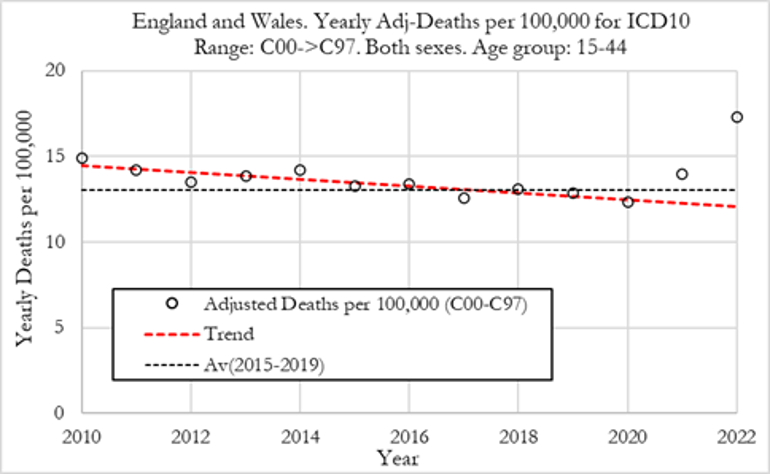
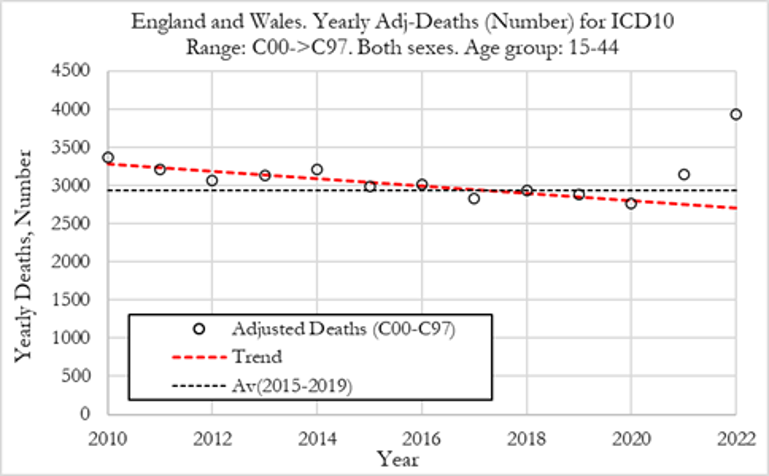
Summary:
-
We can observe that yearly deaths from malignant neoplasms trended lower from 2010 to 2019, with a significant downward slope. In 2010 the deaths rate was 15 per 100,000, in 2019 it was around 12.8 per 100,000, a 14.7% drop.
-
The death rate dropped slightly in 2020 to about 12.5 per 100,000.
-
In 2021 the death rate from malignant neoplasms rose to 14 per 100,000 and in 2022 to 17.5 per 100,000.
-
The death rate in 2022 was about 4.7 deaths per 100,000 above the 2015-2019 average.
-
When translating these numbers into the absolute number of deaths for diseases from malignant neoplasms, shown in Figure (right), we can observe that the 5-year average deaths from 2015 to 2019 was about 3000 deaths. In 2020, malignant neoplasm deaths were about 2,800, 200 less than the prior 5-year average. In 2021 there were about 3200 deaths (200 more than the 2015-2019 average) and in 2022, 4000 (1000 more than the 2015-2019 average).
Disability PIP Clearances for new Claims from Oncologic Causes
The analysis we present here refers to clearances from new claims to the system. It should be noted that clearances refer to decisions made, which can be positive or negative. The fraction of positive clearances (that lead to a grant allowance) is shown to be stable over time at a rate of about 40%.
On our website, we present the analysis of trends in PIP clearances for the different body systems which include interactive charts where the user/researcher can change body system, age of the individuals and trend metric.
The figure shows yearly clearances for new claims to the Personal Independence Payment (PIP) system in the UK for the oncologic system for ages 16 to 44. The dotted line refers to the 2016 to 2019 average yearly number of new claims.
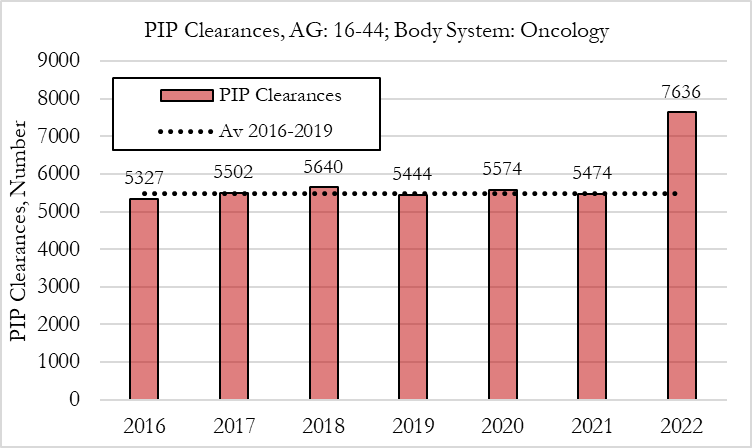
Summary:
-
When we compute the yearly PIP clearances from new claims for the oncologic system, shown in the figure, we observe that PIP clearances were very stable from 2016-2019, at around 5478 per year.
-
We can observe that the 5-year average absolute number of disabilities from 2015 to 2019 was about 5478. In 2020, oncologic disability claims were about 5574, 96 more than the prior 5-year average. In 2021, there were about 5474 disability claims (4 less than the 2015-2019 average) and in 2022, 7636 (2158 more than the 2015-2019 average).
Analysis of Excess Death and Disability Rates from Malignant Neoplasms for ages 15-44
In this section we investigate the trends in excess deaths from malignant neoplasms, with ICD10 codes ranging from C00 to C99, in England and Wales, for the 15-44 age group. We also compare excess deaths for males and females and compute excess disability claims.
Analysis of Excess Adjusted Death Rates from Malignant Neoplasms
In Figure below (left) we can observe that the excess deaths rates from malignant neoplasms were close to zero in 2020, rose by about 13% in 2021 and about 43% in 2022. On the other hand, the excess mortality for all registered deaths UK was about 5% in 2020, 15% in 2021 and 10% in 2022. The drop in excess mortality for all registered deaths in 2022 was not mirrored in a drop in malignant neoplasm deaths. The opposite occurred, with a sharp acceleration in excess deaths due to malignant neoplasms.
When looking at excess deaths from malignant neoplasms, the Z-score in 2020 was around 0, indicating that prior to the start of the vaccinations there was no signal pointing to an increase in malignant neoplasm deaths. That trend however accelerated substantially in 2021 and 2022 where we observe Z-scores of around 5 and 16, respectively. These are extreme events that we believe need a thorough investigation.
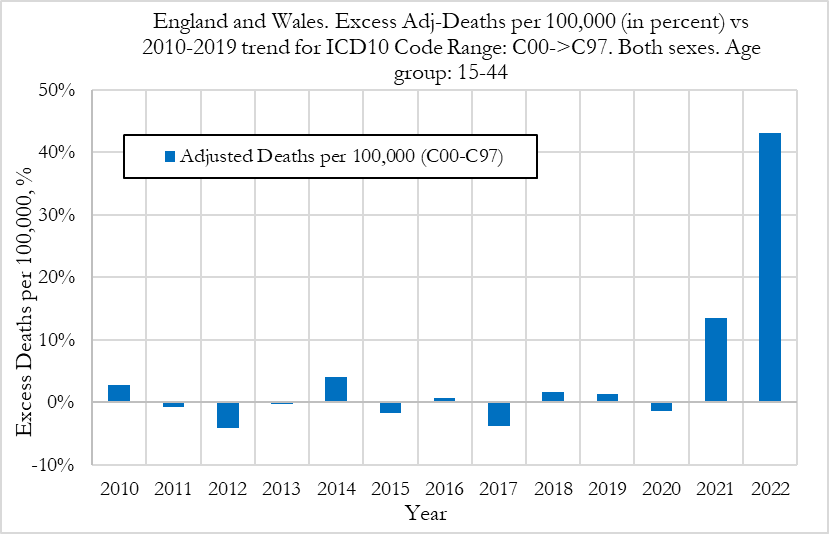

Summary:
-
Our analysis shows that the excess death rates from malignant neoplasms were zero in 2020, +13% in 2021, and about 43% in 2022.
-
The excess mortality from malignant neoplasm deaths in 2021 and 2022 are highly statistically significant with Z-scores of 5 and 16, respectively. These are very strong signals, in particular for 2022.
-
These signals are corroborated by similar findings when measuring rises in the fraction of deaths from malignant neoplasms relative to all other deaths with classified causes (see full report above).
Analysis of Excess Adjusted Death Rates from Malignant Neoplasms for Males and Females
We now compare excess deaths rates from malignant neoplasms for males and females aged 15-44, as shown in the Figure below.
When looking at deaths attributed to malignant neoplasms for males and females, shown in Figure 8, we observe that in 2020 both had no noticeable excess mortality (slightly negative), with respective Z-scores close to zero (low statistical significance).
However, we also observe that in 2021 men suffered slightly worse outcomes than women, with men experiencing a 16% deviation from trend, compared to about 10% for women. In 2022 men suffered much worse outcomes than women, with men experiencing a 52% deviation from trend, compared to about 31% for women.
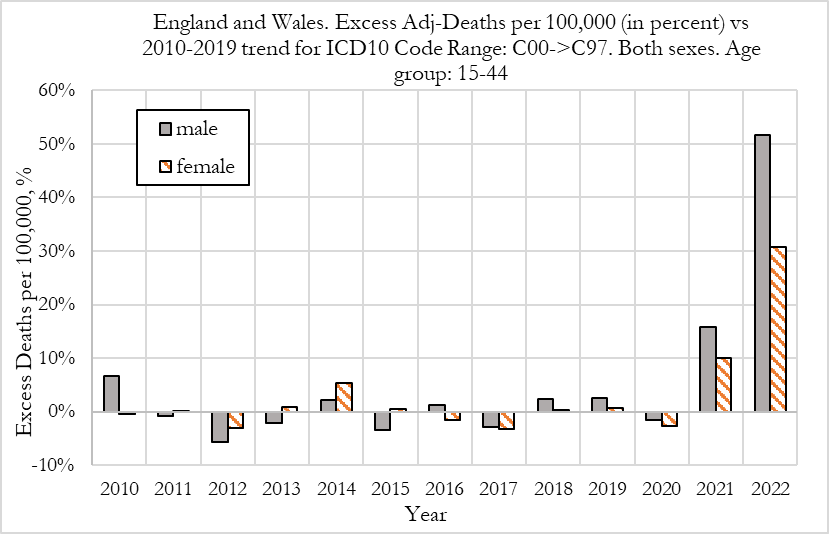
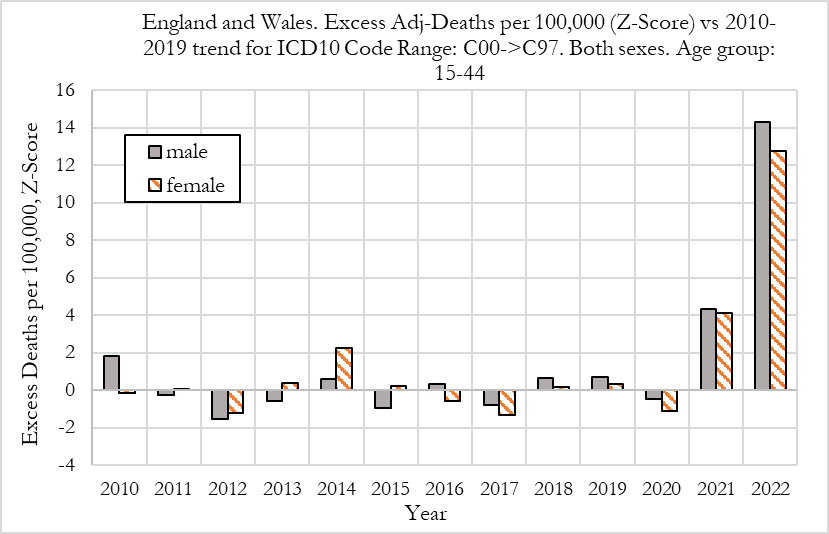
Summary:
-
When comparing outcomes for men and women, we observe that both had a small drop in deaths from malignant neoplasms in 2020.
-
In 2021, men suffered worse outcomes than women, with men experiencing a 16% deviation from trend, compared to about 10% for women.
-
In 2022, men suffered much worse outcomes than women, with men experiencing a 52% deviation from trend, compared to about 30% for women.
-
Further investigation is needed to understand the factors contributing to this difference in malignant cancers for males and females.
Excess Disability PIP Clearances for new Claims from Oncologic Diseases
The figure below shows excess yearly clearances for new claims to the Personal Independence Payment (PIP) system in the UK for the oncologic system for ages 16 to 44, relative to the 2016 to 2019 average number of new claims.
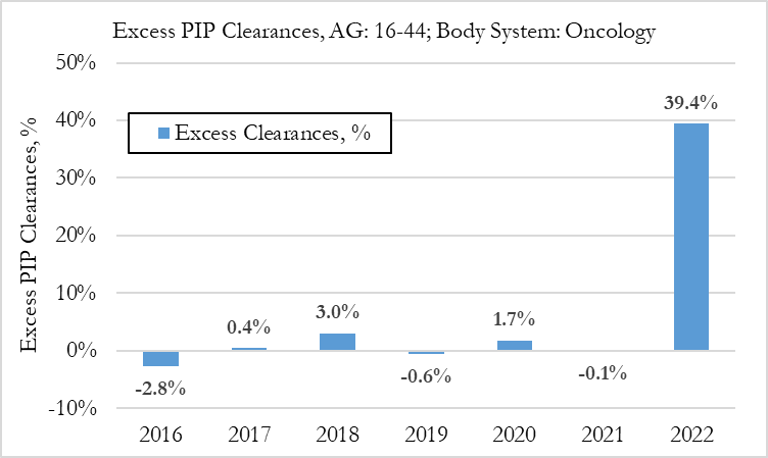
Summary:
-
In 2020 PIP claims increased by about 1.7%, which was a slight increase from the 2016-2019 average. In 2021, PIP clearances were 0.1% below the baseline. However, in 2022, PIP clearances jumped by about 39.4%, relative to the baseline.
-
In terms of absolute numbers, in 2020, cardiovascular disability claims were about 5574, 96 more than the prior 5-year average. In 2021, there were about 5474 disability claims (4 less than the 2015-2019 average) and in 2022, 7636 (2158 more than the 2015-2019 average). The value for 2022 has a high statistical significance (with a Z-score of about 17.9).
-
These trends are in line with similar trends in other body systems. On our website, where present the analysis of trends in PIP clearances for the different body systems which include interactive charts where the user/researcher can change body system, age of the individuals and trend metric.
Conclusions

-
The results shown in table above indicate that there was a significant rise in both disability claims and deaths from oncologic causes, for the 15-44 age group in the UK.
-
We observe that there were close to zero excess rate of disability claims in 2021, and only a rate of 0.88 per 100,000 excess deaths in 2021.
These rates shot up in 2022 with 9.5 per 100,000 excess disability claims and 4.4 per 100,000 excess deaths.
-
We also observe that the relative changes in disabilities were similar to the equivalent rises in deaths, which points towards the risk of higher deaths attributed to malignant neoplasms in the coming years as these conditions remain unresolved.
-
To obtain a rough estimate of the population under risk, we speculate that recipients of the Covid-19 inoculations who suffered (vaccine-related) adverse events could be more susceptible for experiencing malignant neoplasms in the future. The paper by Stephen J. Thomas et al. that establishes the Pfizer vaccine efficacy based on the clinical trial data also provides us an estimate of the rate of adverse events in individuals who took the vaccines versus the placebo group. See the full report for more details.
As the estimated baseline pool of individuals under risk of developing neoplasms in the future is highly uncertain, in the figure above we prefer not to disclose a value on the website as it could anchor espectations. However, we think that it is of relevance for researchers in the field to attempt to narrow down these estimates.
-
When comparing the rise in malignant neoplasms deaths and disabilities with those for the cardiovascular system, we observe that both showed an extremely strong signal in 2022. However, in 2021 while cardiovascular deaths were already high, malignant neoplasm deaths were not. We hypothesise that the medium to longer-term negative effects of the Covid-19 vaccine are starting to surface, first in the form of rising cardiovascular events and later with the rise of malignant neoplasms.
-
The observations above point to a worrying picture that we might see an even greater acceleration of malignant neoplasm deaths and disabilities in the coming years, which makes the investigation of the underlying causes of upmost importance.
-
We are currently in the process of pursuing further investigations into this issue in more detail. In particular, we aim to analyse the trends in deaths for the most common individual ICD10 causes within malignant neoplasms, in order to have insights into the underlying phenomenon of action.









